 |
| Looking back up into the Siete Tazas section |
Siete Tazas
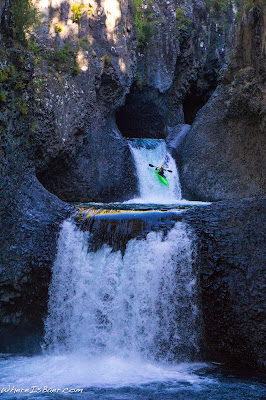 |
| Mark Taylor enjoying the Siete Tazas |
Beta for the Rio Claro sections is marginal, so let's clear it up. As you drive up the valley the first section you will reach is the Siete Tazas (Seven Teacups). Park at the big Siete Tazas sign. During peak tourist season this area will be a zoo. Walk in on the main boardwalk to the viewing platform and scout your exit from the canyon. Most groups don’t paddle the last drop that is directly under the viewing platform. Getting out before the last drop makes the exit from the canyon slightly easier. The hike out is sketchy at best, and many crews will use ropes to extract boats. To reach the put-in from the parking lot, walk up the boardwalk past the restroom to the second flora-fauna sign, hop the guard rail on the left, and make your way upstream on a marginal trail for approximately 200 meters to a rock cairn. From here start your descent into the canyon, I highly encourage using a rope to lower boats on the last pitch.
Entre Saltos
 |
| Aeon lining up one of the marginal entry rapids in Entre Saltos |
The next section up is referred to as the Entre Saltos, or (In-between Waterfalls) and contains one of the most photogenic drops I have ever seen: Garganta Del Diablo (The Devil's Throat) aka Caracol (The Snail) aka Twirly Bird. The exit from this section is not too far above the Siete Tazas put-in, but it is
mandatory to exit the canyon here as the entire river drops into a siphon between the sections. To reach the take-out head upstream on the main road from the Siete Tazas parking lot. Within one kilometer there will be a small turnoff that leads to a bridge which crosses the river and a campground. Cross the bridge and head upstream river left to a set of stairs that go all the way to water level. This is your take-out and you must exit here. Scout it carefully and keep your eyes peeled for the stairs while in the gorge. To reach the put-in continue upstream on the main road to Parque Ingles where the main road crosses the river, and put-in here. There are a couple of marginal rapids in the first kilometer that can be portaged relatively easily. Thankfully as the canyon walls start to close in the drops clean up.
Veintidos Saltos
 |
| alternative driving option, partially up the Veintidos Saltos section |
 |
| Aeon splashing off yet another waterfall |
The section upstream of Entre Saltos is Veintidos Saltos (Twenty Two Waterfalls). From Parque Ingles hike upstream on river right approximately two kilometers. Immediately after the fourth tributary look for a rock cairn. Carefully make your way down towards the river onto a rock ledge, and make your way upstream through a small patch of bamboo and over a high-water strainer. The seal launch is kind of sketchy, so I prefer passing the boats down as a team. All of the drops are clean but very committing. The take-out is the Parque Ingles bridge. If you are interested in lapping this section, take out at the first beach river right as the gorge opens up. This allows you to paddle all of the good drops and shorten the hike considerably.
 |
| life-styling at the shortcut hike up for the Veintidos Saltos section |
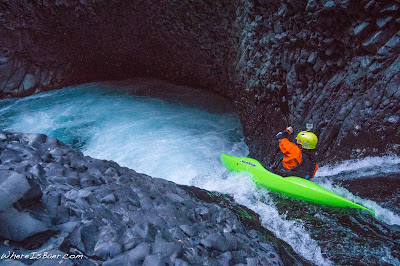 |
| Mark Taylor enjoying one of the twenty-two waterfalls |
La Cocina
 |
| Mark Taylor and Aeon Russo looking into La Cocina |
The uppermost section is only occasionally paddled and is called La Cocina (Kitchen). To reach this section continue to hike upstream river right from the Veintidos put-in for approximately fifteen minutes. Here you’ll find a patch of burnt trees, and at the most upstream portion of these burnt trees there is a trail which leads down to the river. Take out at the Veintidos put-in, or continue down through the Veintidos section to the Parque Ingles Bridge.
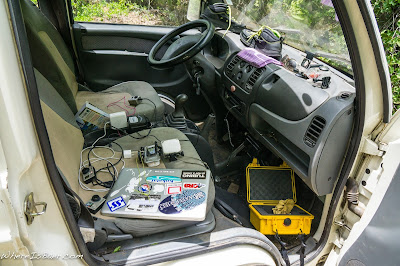 |
| multimedia headquarters |
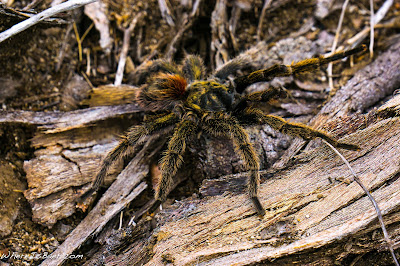 |
| I wasn't kidding these guys are everywhere |
How to Get Out of an Overhung Canyon if You’re Not Chris Sharma.
Mark Taylor, Aeon Russo, and I had been putting laps in on the Veintidos Saltos section and had an absolutely stunning descent on the Entre Saltos section when we bumped into Tino Specht and Evan Garcia. They gave us the heads up that there was a relatively new section upstream of the Veintidos Saltos that people were starting to paddle, La Cocina.
The section starts with a twisting three stage drop. It’s here that I got back-endered. Aeon was directly behind me and partially landed on me at the base of the ledge. During the beating my paddle got blown out of one hand, as I reached up to index the blade I found Aeon’s boat and grasped on. He was able to drag me out of the hydraulic just in time for him to get a stroke off the next six foot boof. Unfortunately this left my boat perpendicular to the canyon, and it broached at the lip of the next ledge. Instantly I was partially ejected from the boat and found myself with one leg in and one leg out of the kayak directly above the six foot ledge. A quick look around and I decided that downstream was the only exit strategy. Head first, I flopped out of my
boat and found myself swimming down a vertically-walled hallway toward the unknown. Without hesitation both Aeon and Mark scouted downstream and found a small ledge where I was able to get out of the water.
The cliff above my perch was just shy of vertical, and I tried a handful of climbing attempts but the sloping, polished basalt finally stifled my upward progress. I was on a small ledge sixty feet above the water. After a quick conversation we decided that the next move would be for Mark and Aeon to head downstream to the Veintidos put-in where they were able to exit the canyon and head back upstream to aid me in my extraction.
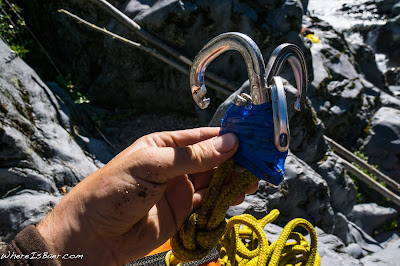 |
| fishing for paddling gear, three carabiners and some electrical tape |
The canyon rim directly above me couldn’t have been worse. The belay station was steep, loose dirt sloping into the canyon. Initially, Aeon and Mark built a simple belay system in order to pendulum me from one route to the next and find a climbable way out. After making marginal progress I was left standing on an even smaller ledge higher off the water, and my climbing skills failed to match the canyon. Aeon and Mark then changed the rope setup into a three-to-one haul system. This system meant that I was absolutely dead weight and couldn’t help them at all. Some grunts later the system was abandoned; there was way too much friction in the system and the location they were pulling from was sketchy at best. The sun was setting and our energy and light were dwindling rapidly, (remember to always carry a
headlamp!). Eventually we settled on a two-to-one system where I was able to help pull on the line. This eliminated a ton of friction and allowed me to participate in the pull. It worked! I clambered up over the last vertical pitch and found the outstretched arms of Aeon and Mark through the dense vegetation obscuring the lip. We collapsed in a group hug. We stumbled back to camp under the new moon.
 |
| Mark Taylor flying off Skate Park |
My Personal Take on Mechanical Advantage Systems
I’m a huge fan of simple, clean systems. A two-to-one system dragged me out of the Rio Claro and it is my go-to system for just about every haul situation. I don’t carry pulleys. They are massively helpful in mechanical advantage systems but I’m not willing to deal with the extra weight and bulk of having them in my
PFD. That being said, friction is a major deficit in any haul system. The average throw bag rope being bent through a carabineer causes somewhere in the neighborhood of a twenty percent loss in power. The average person can pull approximately 100 pounds on a throw rope. So by building a three-to-one mechanical advantage system with carabineers instead of pulleys the actual pull for one person drops from 300 pounds to only 180 pounds. A two-to-one drops from 200 to 160 pounds. Remember these are rough numbers. Now put in friction from vegetation, rocks, and whatever it is that you’re hauling and the systems start to fail.
Be safe out there, know your limitations, learn new skills, and surround yourself with a
solid crew!
 |
| another adventure by Chris Baer |















No comments:
Post a Comment